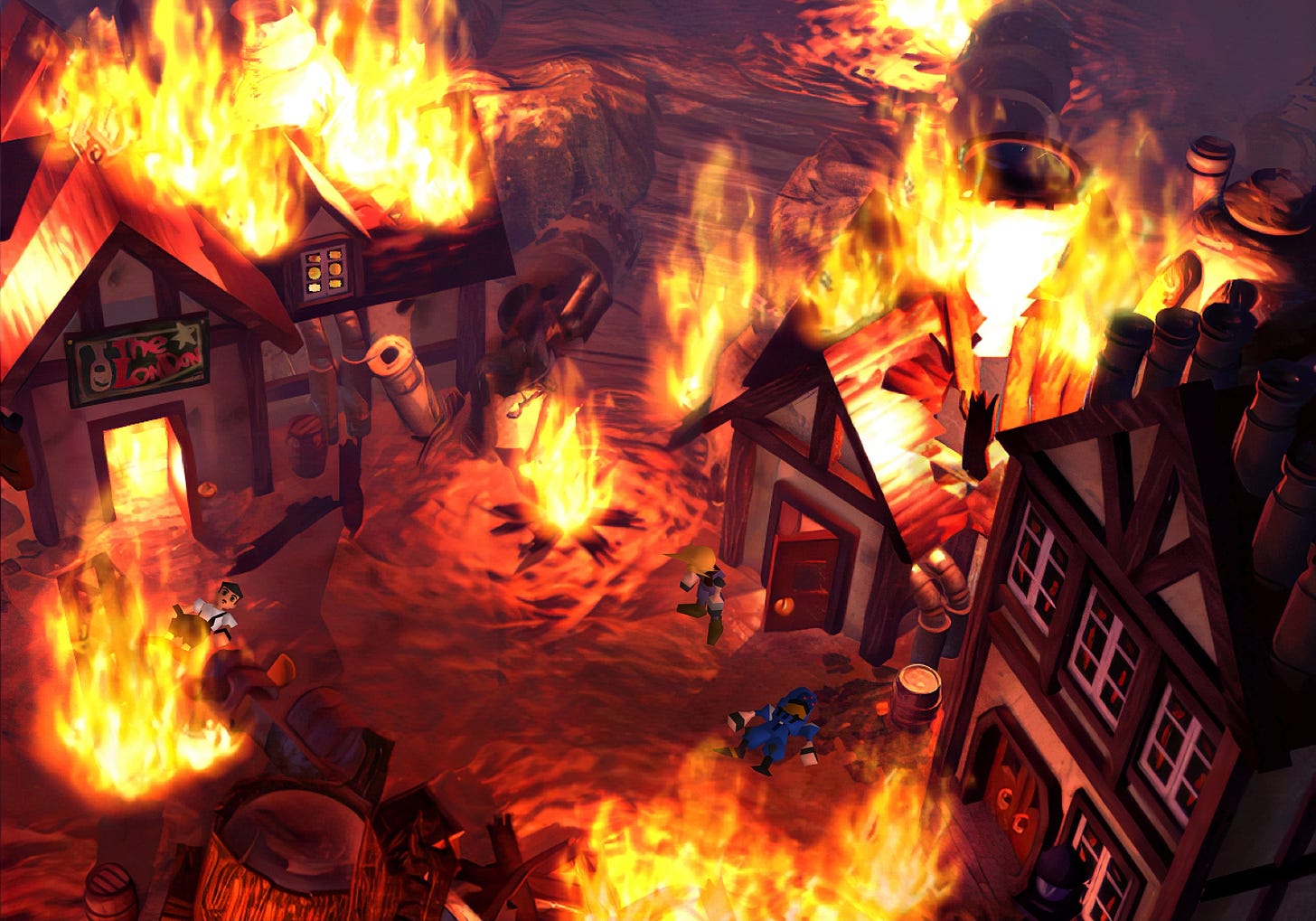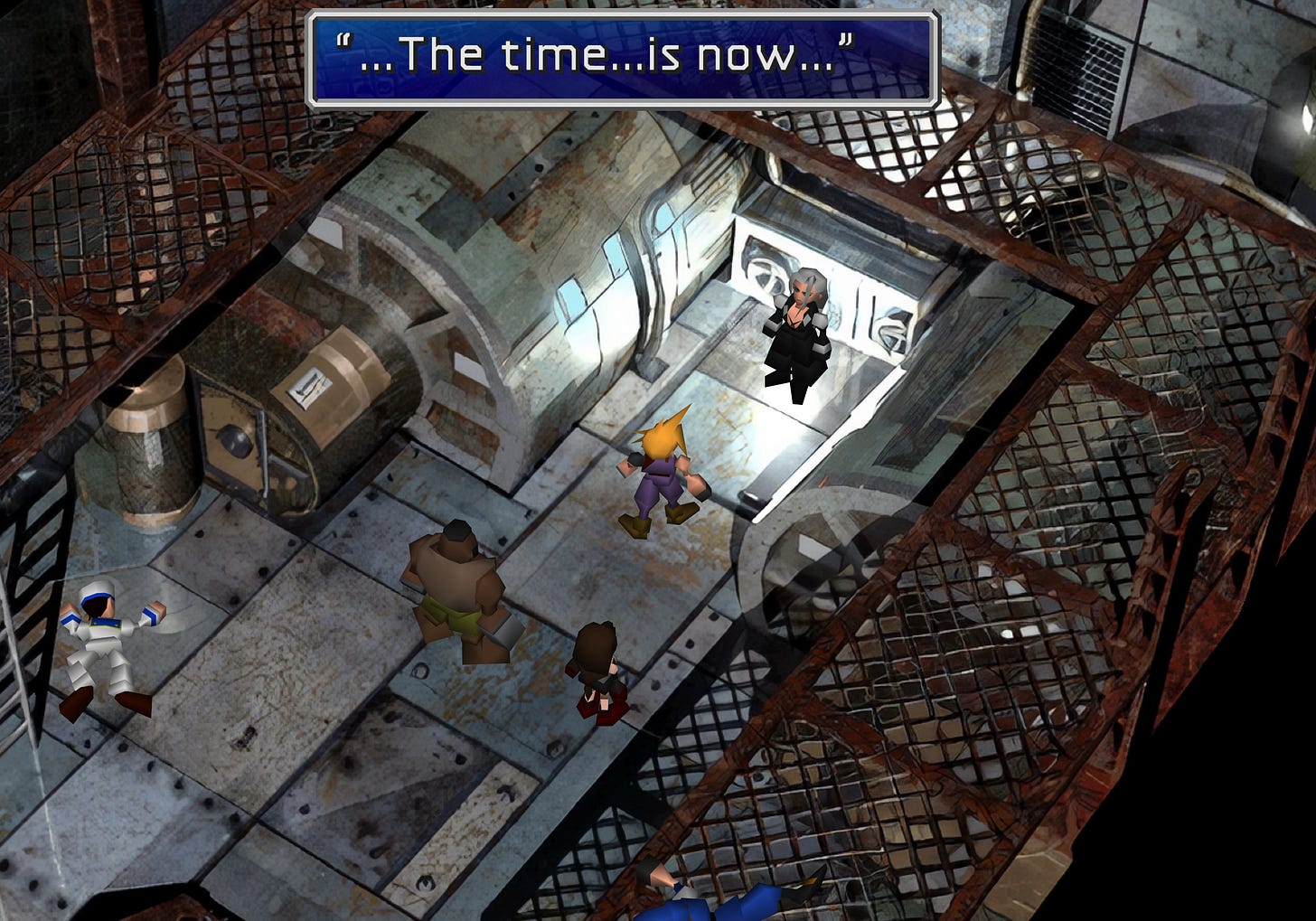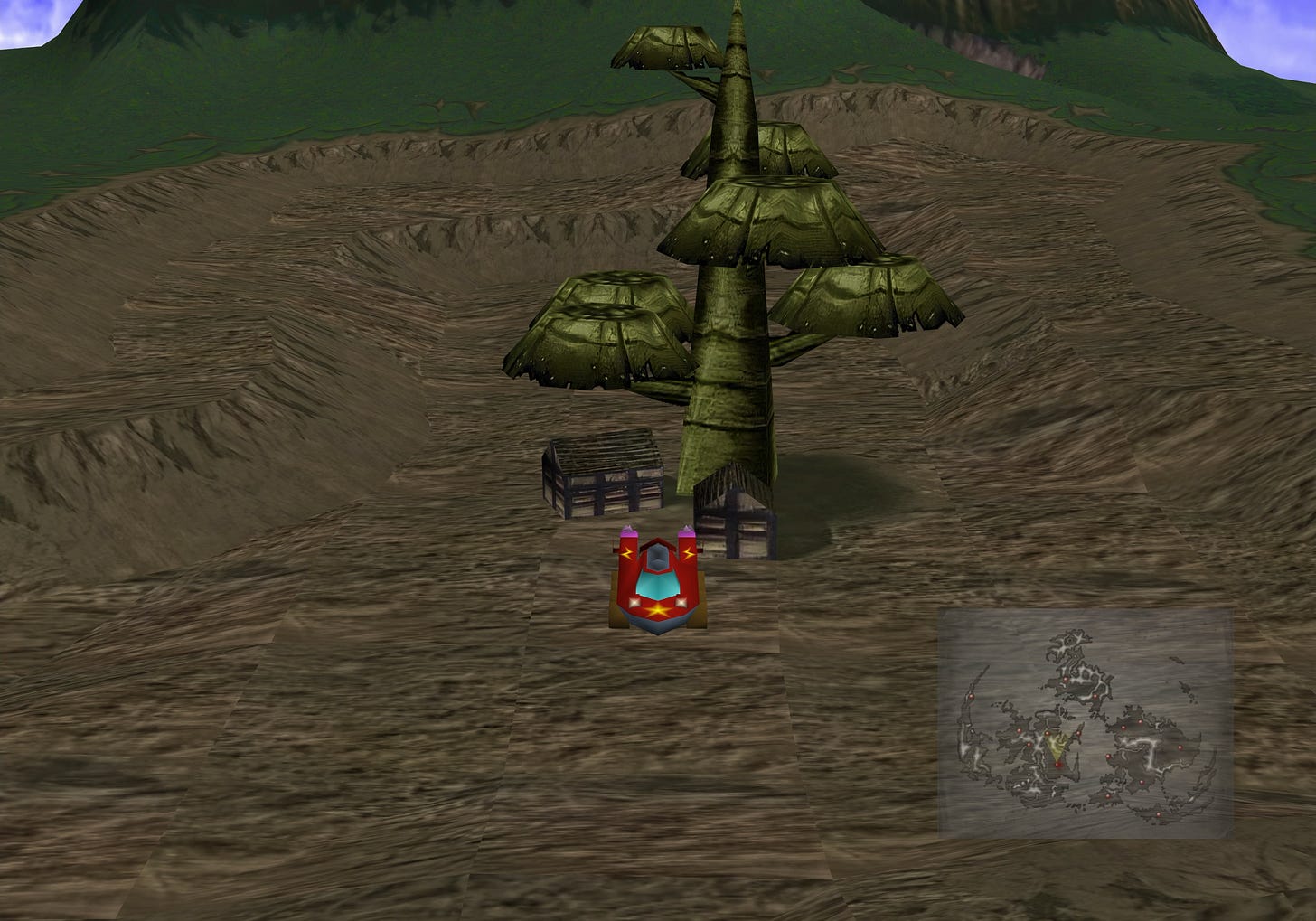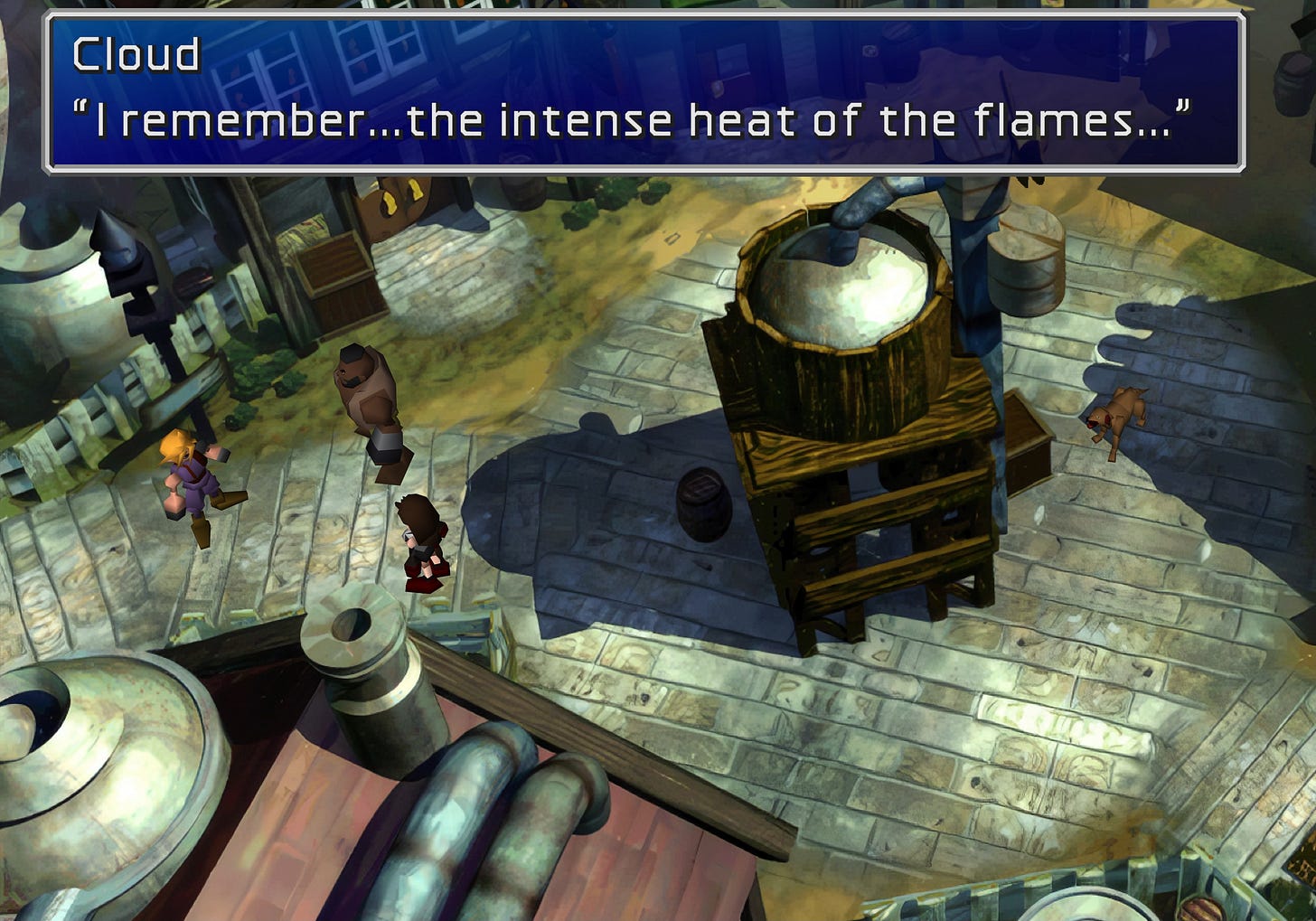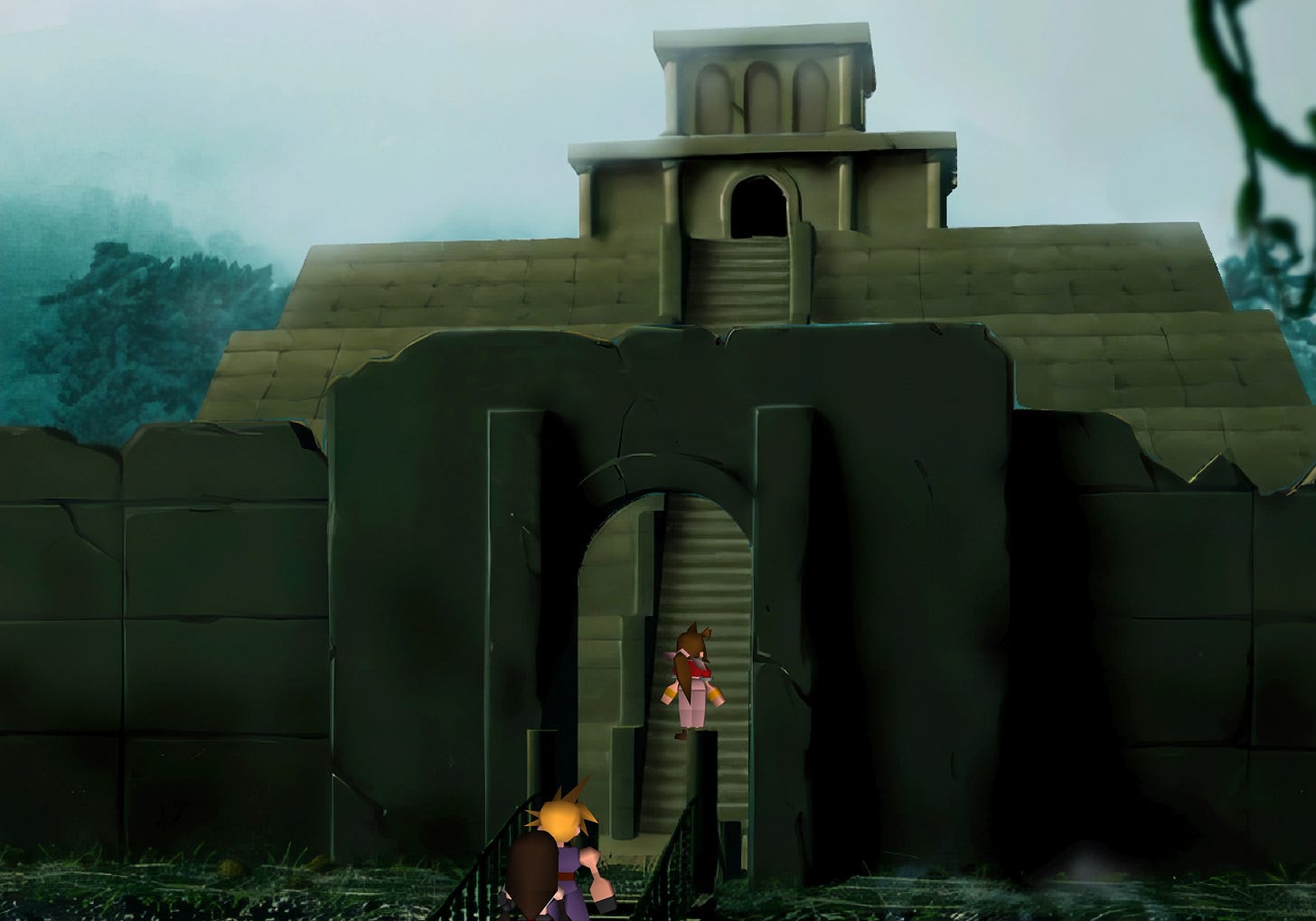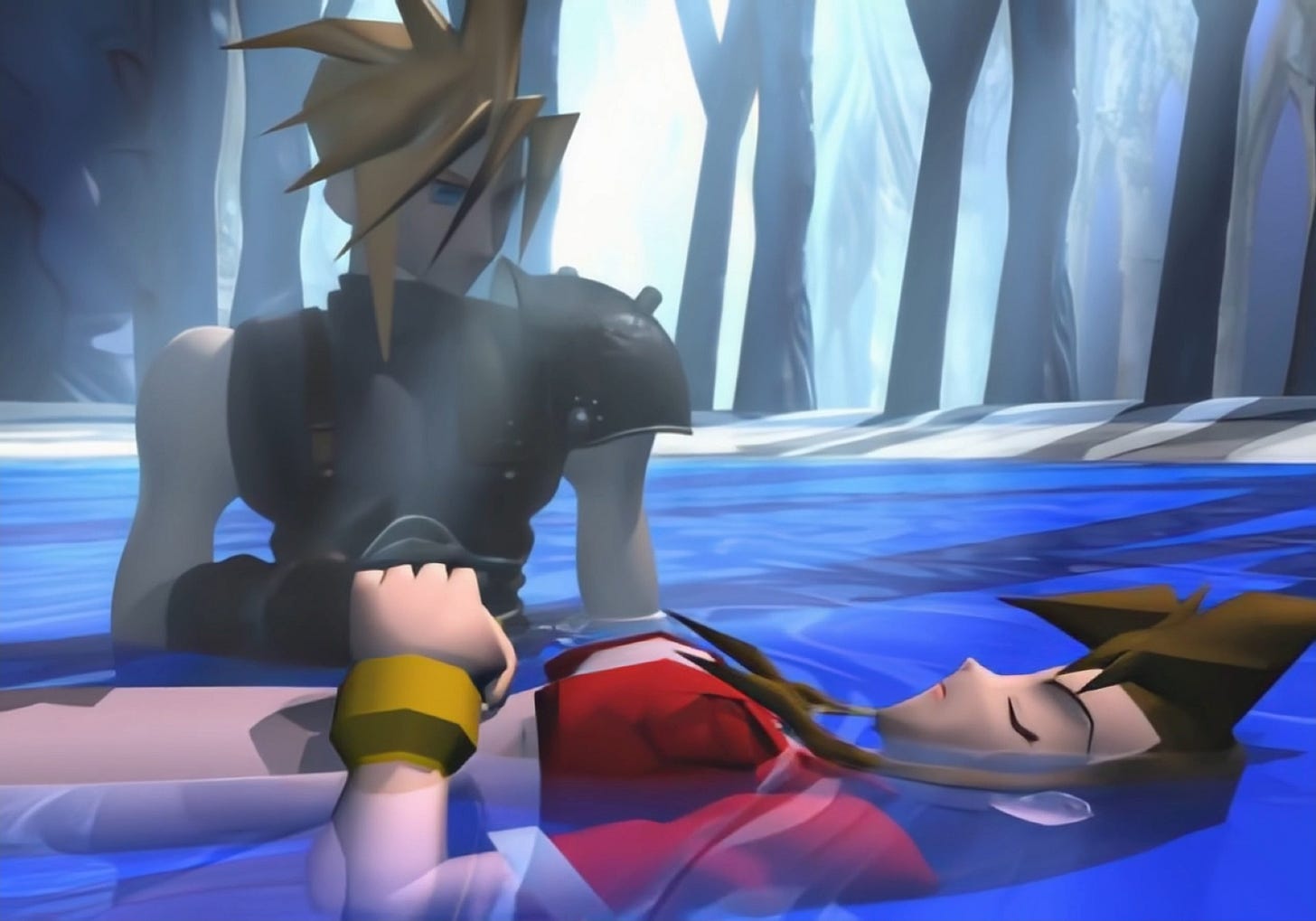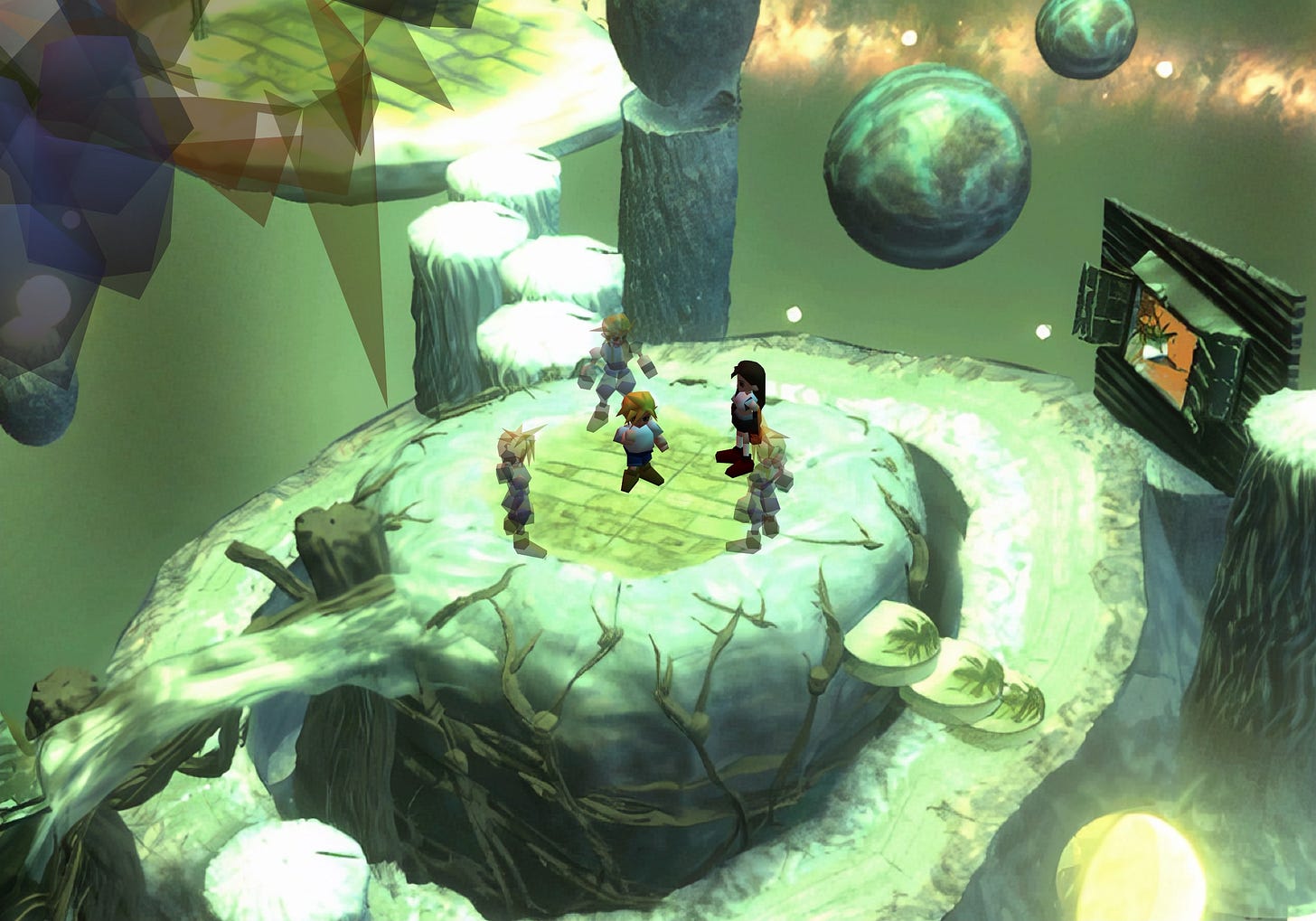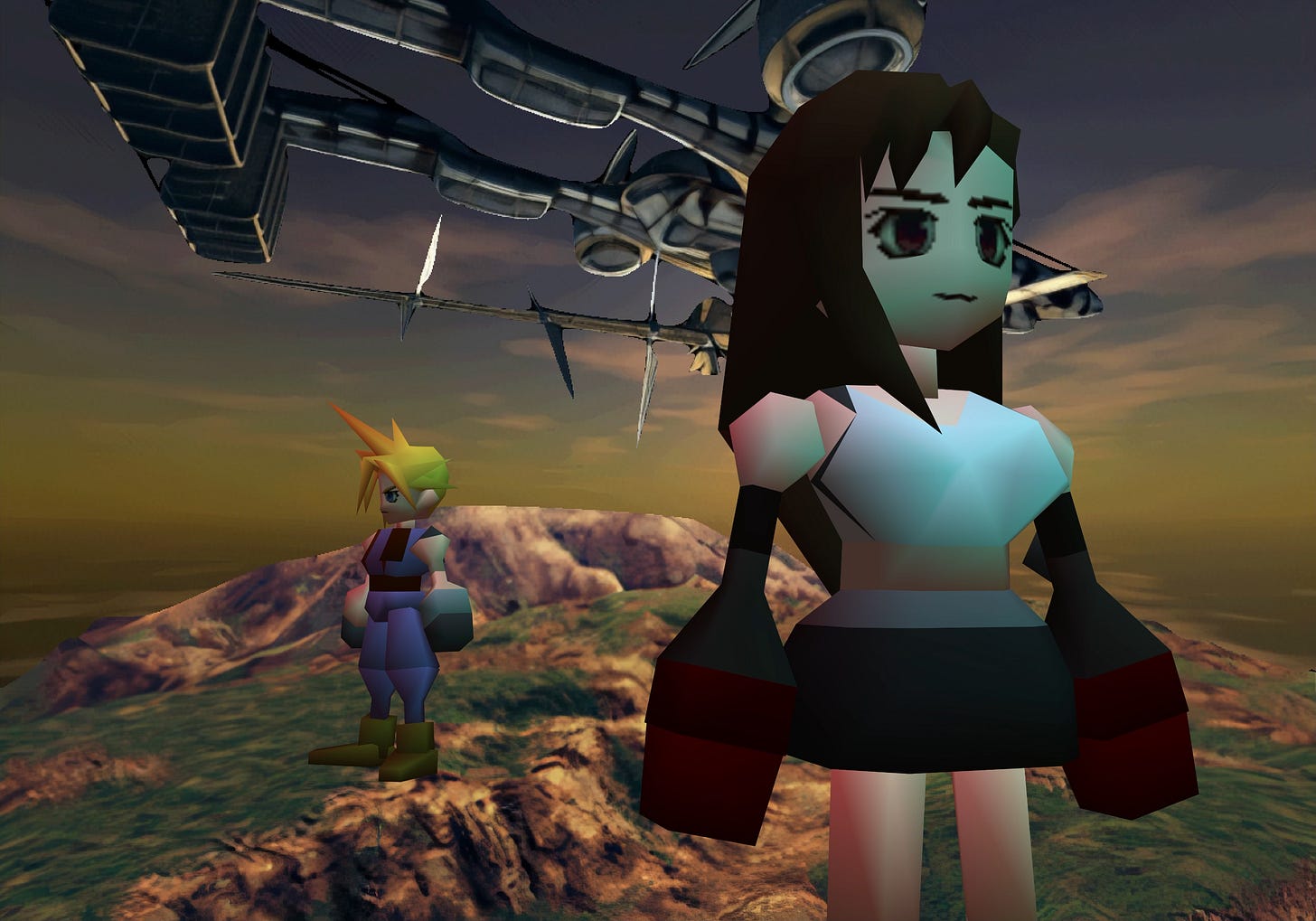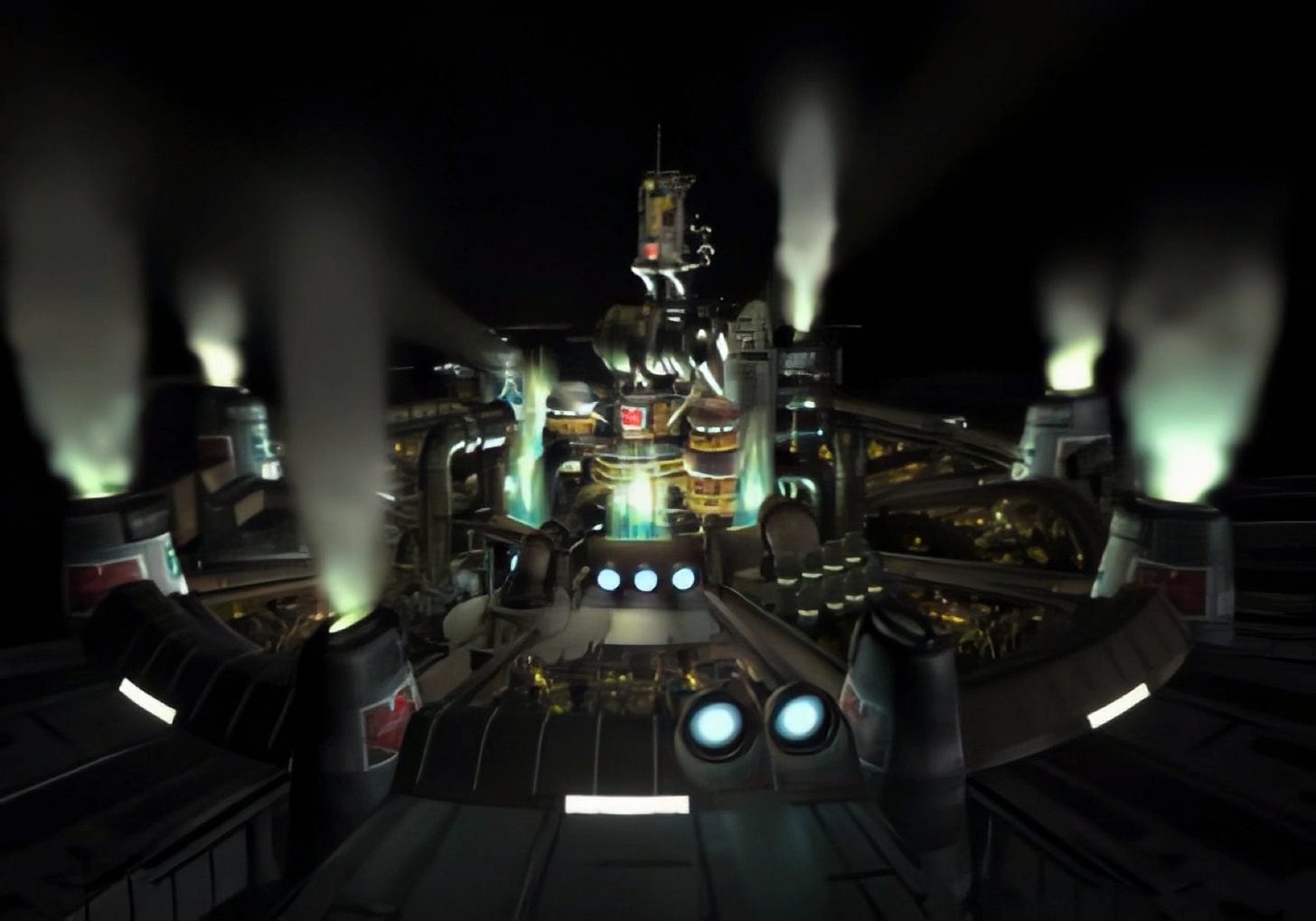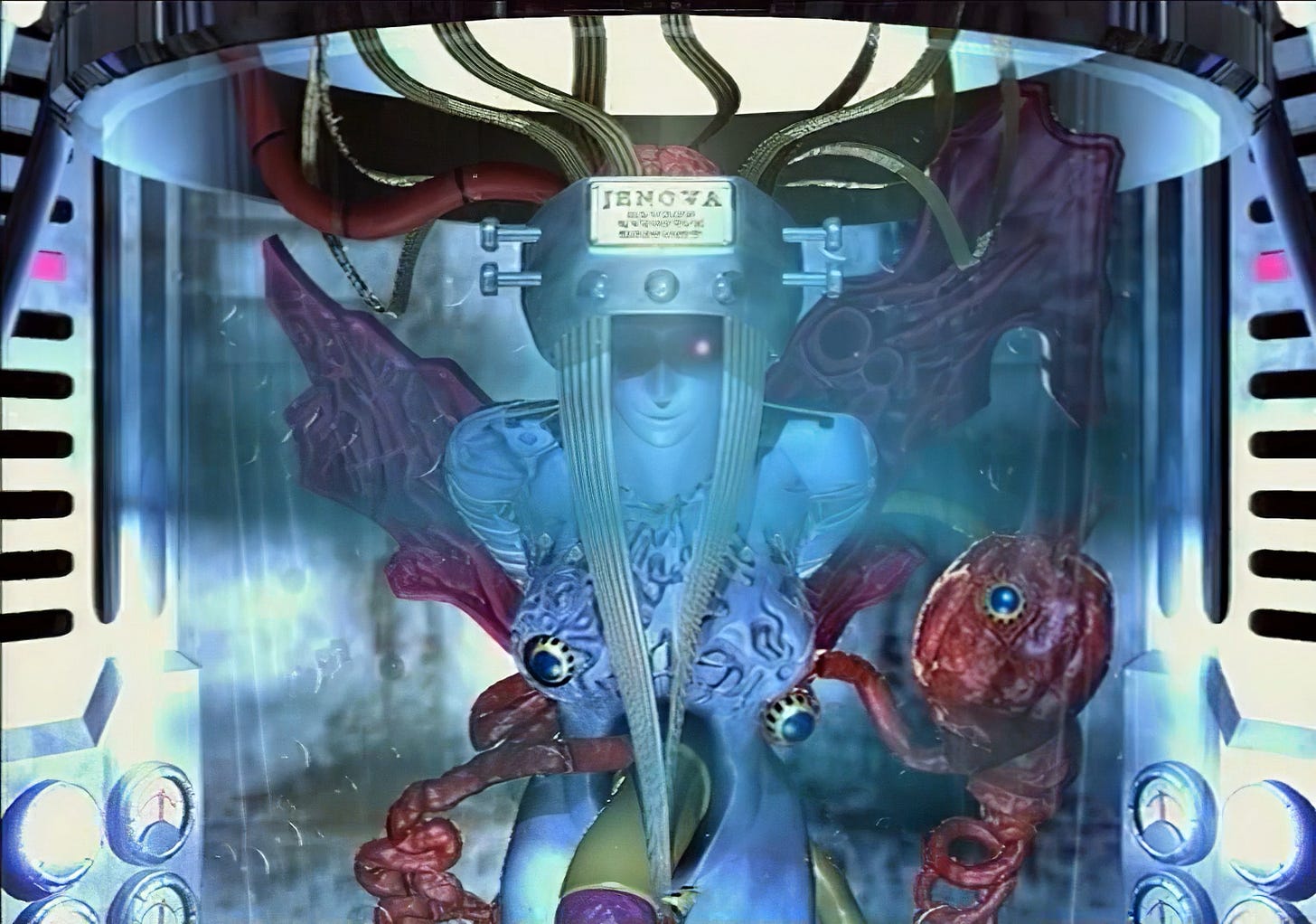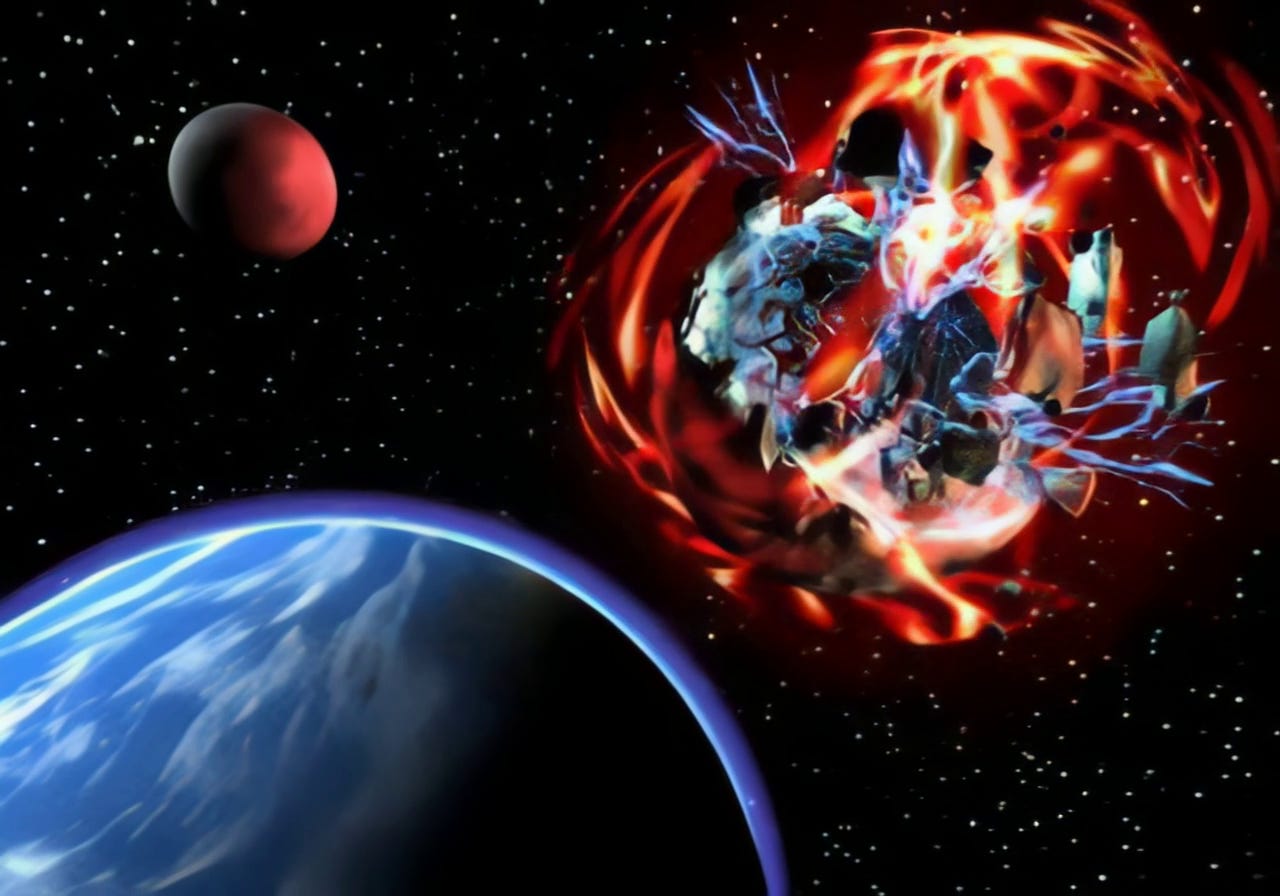How to Split Final Fantasy VII's Story Into Multiple Games
Transcript of our first and only Game Talk video from November 2017 where I present my take on this topic.
This was my very first Final Fantasy VII Remake video after I gave up on recording Let’s Plays. The video which paved the way for our Game Analysis video series which is still going on today, contrary to this one-off production.
As mentioned in the article abstract above, this video was released long before we knew that Final Fantasy VII Remake—the first one of several installments—only contained the Midgar arc and that the whole Remake project would be comprised of 3 entries.
Since my reasoning and prediction still holds up to this day, I thought about posting a transcript of it and revitalize its contents in the run-up to Rebirth’s marketing campaign and eventual reveal of it’s story arc.
With that out of the way: enjoy!
Introduction
Greetings everyone!
My Name is Vyzzuvazzadth and I welcome you to my new series “Game Talk”, where I take a subject in gaming to dissect, discuss and rant about. In this video, I’ll be tackling one of the many debated topics concerning the new direction the Final Fantasy VII Remake is taking, which is the question where Square Enix might or rather should split the original story to make it fit into the multi-part format. And before you rush to the comment section to complain about how they shouldn’t split the game in the first place and how stupid and greedy Square Enix is for doing it, the purpose of this video is not to debate, justify, or even endorse their decision. This high-quality production with high-end graphical presentation—which unfortunately necessitates a multi-part format to prevent a watered-down version—is the direction they’re going for and I’m here to discuss the HOW and not the WHY.
Note: You may skip this next paragraph as it does not pertain to the topic at hand.
Before we dive into this fascinating rabbit hole, I want to provide a small update on the content of my channel. It’s been several months since my last Let’s Play video and I apologize for the lack of content and information. While it was fun to do the recording itself, it took too much time to edit and upload the videos which in turn kept me from being able to play through my game backlog at a decent pace. Besides other reasons like a lack of motivation to do anything productive after work, I simply wanted to enjoy games at my own pace, without the interruptions of the editing process. This is the main reason why I probably won’t be going back to recording Let’s Plays. Instead, I decided to talk about games because it doesn’t interfere with my «gaming habits» so to speak. I went for this particular game and topic first, because it’s what’s on my mind the most lately. To be honest, it has been since the PSX trailer way back in December 2015 and it still is since we haven’t gotten much more substantial information about the game. Seriously, Square Enix. Get your sh*t together and tell us already what the hell you’re doing with this remake!
Ahem…
With this out of the way, let’s continue with today’s topic: How to appropriately split the story of Final Fantasy VII into multiple parts.
Multi-part explanation
First, I want to explain this multi-part structure to get everyone on the same page. Shortly after the gameplay trailer dropped at PSX 2015, Square Enix released a press statement which included the dreaded revelation that Final Fantasy VII Remake will consist of multiple installments.
This means the whole story of Final Fantasy VII will be told across multiple games. It’s NOT split into several smaller episodes like, for example, the Telltale games and Life Is Strange are, even if they accidentally used the term “episodic” once or twice. Kitase-San even clarified in one interview that the Final Fantasy VII Remake is comparable to the Final Fantasy XIII trilogy in size and scope. Which means we could be expecting 3 full Final Fantasy games in the end.
So far, it’s not known how many installments the Remake will consist of nor where the splits will occur. Now, I personally think they will go for a trilogy for the following reasons.
2 parts would kind of feel weird and cheap. Kind of like: “Well, there was too much content for one single installment, so we just chopped it up in the middle. Here you go. Enjoy!”1
With only 2 parts, both games wouldn’t feel like individual games, but rather half a game each. This will become clear a little later.
4 Installments would be too many when we’re talking about full games. A lot of needless padding would most likely be needed to achieve this.
So, 3 parts sounds like a sweet spot.
In addition to that, trilogies are a tried and working concept. It’s like a 3-act structure with a beginning, middle and an end. Hence, it works better even from a story structure perspective.
How to find appropriate splitting points
Now that we’ve established a trilogy being the most suitable format for the Final Fantasy VII Remake, let’s define the must-have criteria for each part.
Each installment needs to have its own story arc to feel like a complete experience. Meaning, it needs to consist of a self-contained story and doesn’t just stop in the middle of things. Besides that, a complete story arc also works in the favor of long wait times between parts, which presumably span over 1 or 2 years2.
Each part needs to have enough content to fill a full game. Thankfully, Square Enix have confirmed that they will expand on existing material, especially Midgar, so there’s enough wiggle room for this one.
The beginning needs to set up the tone and genre for the rest of that specific part. This is important for any story regardless of the media it’s told in. Furthermore, the beginning needs to act as a gameplay tutorial for the rest of the game. Of course, not all gameplay elements should be taught to the player right at the start. I’m only talking about the basic ones.
The conclusion of the game should contain an epic last dungeon fitting the setting and end with a satisfying batch of final bosses which conclude the story arc of the respective part. Before that last dungeon, backtracking must be possible to enable the player to wrap up unfinished business. Ideally, the last dungeon can be exited as well, as far as the player hasn’t crossed the point of no return. On top of that, the ending segment, or the ending itself, should hint at the theme of, characters from, or events in the next part.
Finally, each part must adhere to the 3-arc structure. Sure, they could use another structure—like the 5-act structure or the Hero’s Journey—to tell the story of one part, but for the sake of this discussion, let’s settle for the 3-act structure. More on that later.
Aside from those must-have criteria, there are also a few other things that each part needs to contain. However, these criteria are generally flexible and thus can be bent to achieve the “full game” requirement.
First one is gameplay content like equipment, limits, items, Materia, character progression, treasure location etcetera. There’s no reason to just leave the state of the original game untouched. There can be new weapons and Materia, the characters can receive some Materia much earlier or later or not at all in a specific part; they’re essentially free to mess with those things as they please, if it makes sense and is not detrimental for any part. Just don’t cut anything out, please! I want my Nail Bat,3 Barret’s Rocket Punch,4 Aerith’s Umbrella, Cover, Counter,5 Final Attack and the Underwater Materia! I can dream, can’t I…? Moving on:
Bosses can be added, be it mandatory or optional ones.6 They essentially have to, since in the original game, most optional bosses were in the second half of the game.
Character arcs can also be expanded upon or shifted a little to fit the new structure, as long as they don’t cut anything substantial or important. This applies to anything story related, in fact.
New mandatory activities between existing story segments as well as new side quests are welcome at any point where needed. Especially the first half of the original game was pretty lacking in the optional content department.
On top of that, each part can and should have new optional dungeons and super bosses, since those are also only a thing near the end of the original game.
Traversal time is also variable, since it heavily depends on the level design, which won’t be the same due to the jump from pre-rendered backgrounds to fully realized 3D environments.
This being said, only the mandatory criteria are relevant for my suggestion on where to split the story. The flexible ones I just mentioned are irrelevant in finding appropriate splitting points as they can be bent to fit within anything.
Splitting points that don’t work well
Before I reveal my conclusion of where to split the story, let me list some splitting points I’ve heard people suggest, which I think don’t fit or don’t make sense at all. Some I’ve added for the sake of completion to cover all the bases.
Kalm Flashback
The first point is right after the Kalm flashback. The main villain has just been introduced and then the game ends. There isn’t even a boss battle or a last dungeon. Remember, everything the player does in this flashback has no bearing on the rest of the game whatsoever, so dragging this section out to include more gameplay and bosses is detrimental to the pacing and character progression. The flashback should be as condensed as possible from a gameplay-perspective to keep the player from wasting time on things that don’t affect the rest of the game. Furthermore, sitting through a flashback after the action-packed raid on Shinra headquarters and the escape on the highway is a very bad and dragged-out ending for a game. On top of that, starting part 2 when leaving Kalm doesn’t provide an interesting hook and the lack of any sort of introduction is the antithesis of a great start.
Jenova Battle on the Cargo Ship
The next point is the Jenova battle on the cargo ship before reaching Costa del Sol. The only reasons I’ve heard so far for this point are “We get more content in part 1” and “it’s a good point, because we’re off to a new continent”. There are several problems with this suggestion. Sephiroth has only been properly introduced recently and the chase for him is in full swing. Ending a game in the middle of an arc is detrimental to the whole experience. The argument that they could extend the ship to make it a proper dungeon doesn’t make much sense either, since the dungeon part of this segment doesn’t start until the alarm goes off and our crew go check if it’s Sephiroth. Going through a ship dungeon the size of Shinra Headquarters, the last Midgar raid or even the Northern Crater dungeon would break the whole pacing while adding nothing of value to the current situation. And just like the flashback suggestion, starting a game in a beach resort town while already being on the hunt for Sephiroth who got introduced in the last quarter of the previous game is jarring and confusing to the player.
During the Journey to the City of the Ancients
Now, there are more points between the cargo ship and the City of the Ancients, where the fated backstabbing happens. The reasons for those points are “we’ll have more characters in part 1!” or “there’s more content in part 1.” All of them present even more problems than the previous suggestion. There’s no specific buildup to those points and they don’t provide any conclusion to anything established so far. There are also the same problems present about the start of part 2 as well as the length of it and a possible part 3. Remember: each part needs to have its own arc and should result in a full game.
Gold Saucer
Let’s start with Gold Saucer. This location is mainly about Barret’s character arc and is only a minor part in the grand scheme of things. Also, ending with a Chocobo race? Seriously? And to top it off: the game ends, when the receive our first vehicle.
*silence*
…yay?
Cosmo Canyon
On to Cosmo Canyon. Its purpose is to learn more about Red XIII and the Lifestream, which is an important setup for the events in the Temple of the Ancients and the City of the Ancients. Now, the Gi tribe have nothing to do with the story besides Red XIII’s character arc, so ending with Gi Nattak as the final boss would leave players confused and upset and rightly so. There’s no conclusion to anything set up prior to this location and it has nothing to do with Sephiroth.
Nibelheim
Let’s move on to Nibelheim. Granted, the crew revisits the place introduced in the flashback, but nothing happens here to conclude anything. It only adds more mystery to the events 5 years ago. Also, who wants to start a game where the characters are in the middle of the chase for Sephiroth and visit Rocket Town as the first location?
Rocket Town
Speaking of which, there’s also nothing to end on in Rocket Town. Yes, we’ll have all playable characters by then, but what’s the point? Vincent didn’t have any development so far and Cid just joined the party. Starting a game just after acquiring the plane turned boat where you have kind of an open world gameplay for the first time is not helping anyone. Neither does the lack of an introduction to a story arc.
Temple of the Ancients
Next up is the Temple of the Ancients. Aerith just left the party, which experienced a major setback by losing the Black Materia and Cloud just had his first episode of identity crisis. There’s no resolution, just higher stakes and more questions. Sephiroth’s real plan and thus Meteor just got introduced. Such a cliffhanger would kill the flow of the story, since there’s no conclusion to any story arc.
End of Disc 1
The next point is a little trickier, since it seems like a great point to conclude part 1 or even part 2. Of course, I’m talking about Aerith’s death or more accurately, her burial. Reasons in favor of this suggestion are the easy backtracking before the City of the Ancients which in turn can serve as a cool last dungeon if done right. The overall gameplay structure fits well, since after her demise, the game becomes linear again, which is ideal for starting the next part. Furthermore, ending with the death of a main character and her burial makes for a very emotional conclusion to the game.
Unfortunately, there are much more downsides to this ending point when digging deeper. As emotional and final Aerith’s death might be, ending the game here is in fact detrimental to the weight of her demise. The next part won’t be out until 1 or 2 years later and the shock of the previous part’s ending has subsided and doesn’t sit as deep in the player’s hearts anymore. (side note: this mainly applies to newcomers, since the fans already know about that twist). If the game continues right after her death, it is much more impactful, especially when watching the tapes from professor Gast at Aerith’s birthplace Icicle Inn a bit later and the player feels the loss directly through gameplay as well. Additionally, there are unresolved plotlines like the Black Materia and Meteor, as well as the Reunion, which work against the idea of a finished game. Lastly, as with so many other bad splitting points, the next part would start off very weak. You run around in a snow region, visit a snow town that has little significance outside of professor Gast’s video tapes and the town being Aerith’s birth place, then go snowboarding… I think you can already see the problem. There’s no proper introduction or even beginning of a story arc nor an interesting hook that keeps the player wanting to move along with the plot.
Cloud’s Recovery
The penultimate point I’m going to cover is Cloud’s full recovery. One problem is that there’s not much left after that besides the remaining Huge Materia missions and then the multi-stage conclusion of the story. But that’s not even the worst thing. Cloud’s recovery is a pure story segment with no dungeon, no battles and no bosses. Ending with this segment would feel like a very long dragged out epilogue a.k.a. the ending of the extended version of Lord of the Rings: The Return of the King7, which is even worse in a game, where gameplay is king. And I guess I don’t need to mention that the last part would start in the middle of the Huge Materia quest without any introduction or setup whatsoever.
End of disc 2
Finally, let’s look at the end of disc 2 as the last one of bad splitting points. At first glance, it doesn’t sound like such a bad idea. The Raid on Midgar contains a nice final dungeon and meaningful final bosses, namely the Proud Clod and Hojo’s 3 forms. It also ends the Shinra arc and includes the last encounter with the Turks. It even has a short time of relief on and beneath the Highwind to round up this part.
There’s just one big huge gigantic problem with this. Are you ready?
*breathes in*
There’s literally only the final dungeon and the final boss battle of the whole game left for the last part! Seriously!
I can already see the pre-credits screen reading. “Experience the epic and climactic ending of the Sephiroth arc in the Final Encounter DLC for just 9,99. Coming soon to all digital stores. Thank you for playing!”
*sigh*
All jokes aside, there’s just not enough material left for the last part to fill even a quarter of a full game. This fact alone throws any argument for this splitting point out of the window and straight into the garbage container.
Now with all those unfitting splitting points off the table, let’s continue with the next segment.
3-Act structure
Before I reveal my proposal for the splitting points, I need to go into theory mode for a bit. As I mentioned earlier in this video, I’ve decided to settle for the 3-act structure8 as one of the mandatory criteria for splitting the story. Some of you might not be familiar with the 3-act structure, so I will now summarize its concept.
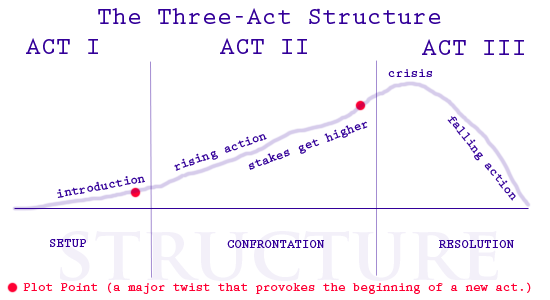
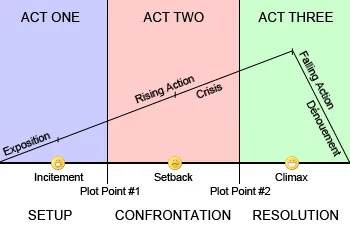
Disclaimer: I didn’t study literature or screenwriting so I had to do a fair amount of research beforehand. If you’re well versed in this subject and notice a glaring error in my feeble attempt to sound competent, please let me know down below in the comments.
Alright, here we go.
Summary
Act 1 serves as the setup as it introduces setting, world, the major characters and the conflict that moves the story forward. In addition to that, it contains 3 important points: the hook, the inciting incident and plot point I.
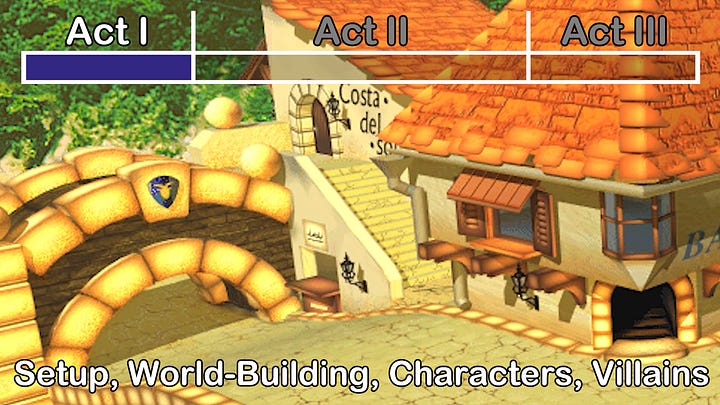
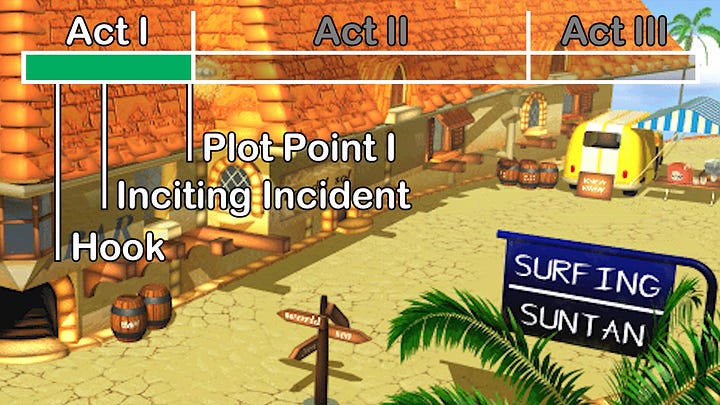
The hook is an event or a situation, that grabs the audience’s attention to really dive into the story.
The inciting incident is an event which sets the protagonist on the path by changing their routine and challenge or encourage them to go down a certain path.
The plot point 1 is usually an event that leads the protagonist to make a choice, which creates a point of no return. The protagonist crosses a threshold after which they cannot return to their former life, leading into act 2. Sometimes, the choice is also made for them, depending on circumstance and story.
Act 2 is all about the confrontation with the main villain in the story and by far the longest. It’s where most of the character arcs are told and subplots transpire. Many events during act 2 are not necessarily connected to the main plot, but still relevant to the overall narrative and linked to the central theme.
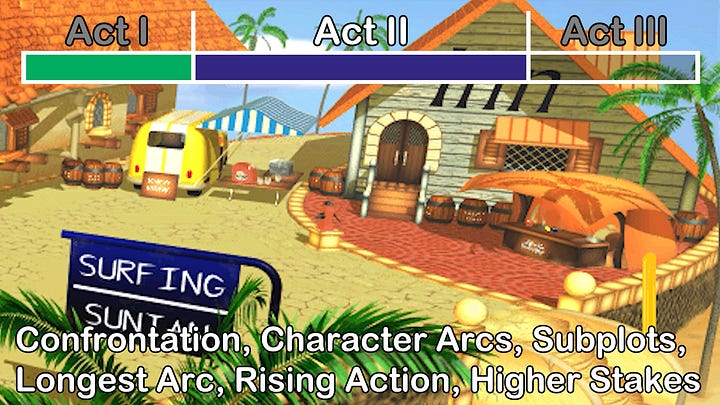
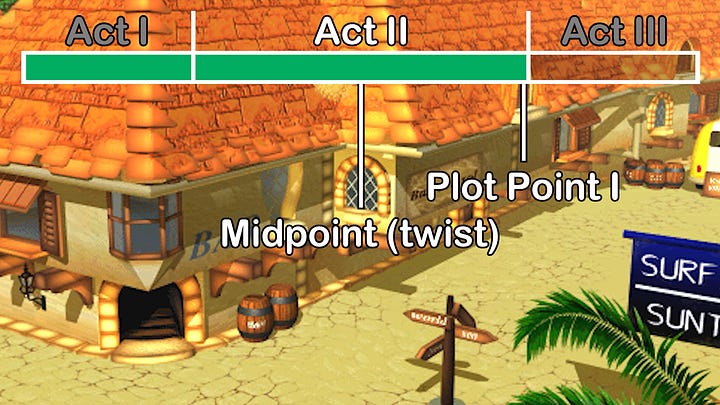
Act 2 can also be called the “new world”, as the protagonist has left their previous life behind.
During act 2, the action keeps rising and the stakes keep increasing until we reach plot point 2
Before plot point 2, there’s the midpoint, which happens around the middle of the arc and it’s where the protagonist seems to reach their goal, but certain events prevent success.
Plot point 2 happens at the end of act 2 and catapults the story into act 3. This is usually a moment of crisis where all hope seems lost. At this point, the protagonist will reach their lowest point and often give up in despair.
Act 3 contains the resolution to the story. All loose ends are tied up here, for example subplots and character arcs, and after some preparations the protagonist comes face to face with the villain, resulting in the long-awaited climax, which is followed by the falling action—as in events after the climax and before everything is finally over. Then comes the denouement, in which the story comes to its conclusion.
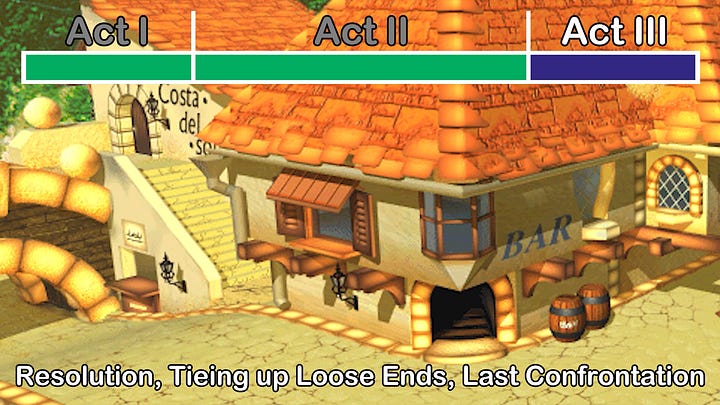
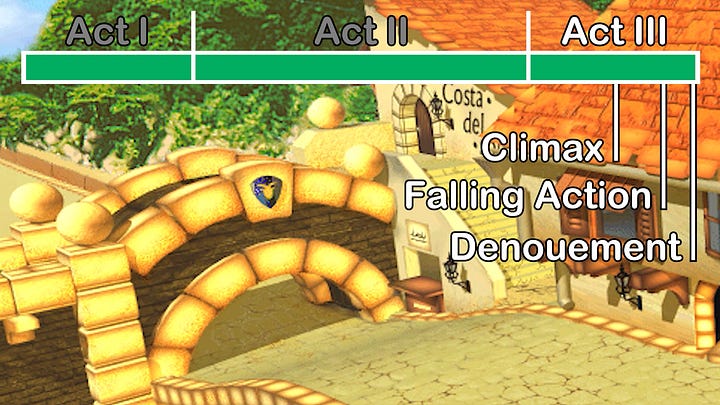
You still with me? Good. There will be a test tomorrow.
*pause*
I’m kidding guys! …or am I…?
Anyway, let’s continue.
3-Act Structure Applied to the Original Story
The original game had—at least in my eyes—a clear cut 3-act story. During my research, I found a couple of articles which tried to apply the 3-act structure to the original game. Every single one of them claim that the 3 discs represent the 3 acts. I strongly disagree with that conclusion, for a multitude of reasons:
Act 1 would be way too long, since disc 1 contains roughly 60% of the whole story and as we know, act 2 is the longest. Furthermore, act 1 is the setup and introduction part. Dragging this out to 60% alone sounds ludicrous. Especially since there are already many characteristics of act 2 present in disc 1, namely rising action and continuously higher stakes, more character development, subplots, and finally the main element of act 2—the confrontation, which technically starts with the flashback and really takes off on the cargo ship.
With Aerith’s death being plot point 1, we have the following problem: it doesn't drastically change the crew's situation. They're already hunting down Sephiroth, because he wants to end the world by summoning Meteor by using the Black Materia, which he already possesses. The stakes just got even higher by losing the last ancient, who could summon the counter spell to Meteor, which indicates already being in act 2. All this event does is strengthen the commitment of Cloud and the gang to finish off Sephiroth. They only got an additional reason. Granted, the act of killing Aerith makes it impossible for Cloud to throw the towel, since it has now become personal. Very personal.
People who claim disc 1 to be act 1 also suggest that the death of president Shinra represents the inciting incident. It’s more than that. The inciting incident is merely the kick-off point for the plot, like when Luke Skywalker sees Leia’s hologram message and makes the decision to follow her plea. President Shinra’s death is not a kick-off point where Cloud decides to become active. It’s the point of no return and the beginning of the new world. The protagonist can still turn back after the inciting incident. After the plot point 1 however, he literally can’t. To make another Star Wars comparison: after the empire kills Luke’s uncle and aunt, his old life is over and he has to move forward. There’s nothing to return to.
There’s also a similar problem with act 2 ending with disc 2. Act 2 ends with plot point 2, which is the lowest point for the protagonist. The major crisis, where everything goes sideways. Do you see the problem already? Disc 2 ends with the Midgar Raid, where Cloud and the gang are victorious! They eliminate Gyahaha and Kyahaha,9 vanquish the pale lab coat who went bonkers,10 and Shinra junior already got wiped out by Diamond Weapon’s attack on Midgar.
Yes, wiped out. Advent Children doesn’t count. In my head canon, he’s dead. Gone. Incinerated to dust and scattered all over the wasteland around Midgar.
Oh, and they defeat the Turks as well—unless they are scared kittens and settle for a draw. I guess I made my point.
Revealing my proposal
Alright, now we’re finally at the point where I’m ready to reveal my proposal for the ideal splitting points in the Final Fantasy VII Remake multi-part series. Although you can probably already guess which ones they are, since those are the only ones I haven’t covered in the bad splitting point section. Anyway, I hereby present my version of the 3-act structure of Final Fantasy VII, which implicitly splits the game into the 3 parts of the Remake.
Act I: Shinra Inc.
Act 1 covers the first Shinra arc. It introduces the more important characters Cloud, Barret, Tifa, and Aerith and the villain Shinra Inc. which consists of President Trum… I mean President Shinra, the other executives—Palmer, Heidegger, Scarlet and Reeve—the Turks and, of course, Hojo. It also sets up the concept of Mako and Shinra’s exploitation thereof, harming the planet in the process. Towards the end, we learn about the actual villain, Sephiroth, who was only briefly mentioned a few times before. We also meet Red XIII, but only at the very end. He’s mainly used to show how twisted and sick Hojo is, which is why I think Red XIII will only be a guest character in part 1.11 The setup of Hojo is also very important for later, since he’s in fact the main cause of most things that happen in Final Fantasy VII.
Now let’s check the 3 main stations in act 1.
The hook: This is of course the first bombing mission and the escape afterwards. We also get a glimpse of Cloud’s mental state. Even more so in the Remake, since he has another brief seizure or memory flash during his encounter with the Shinra grunts.
The inciting incident: I'm a little unsure on this one. It’s either when Cloud falls into Aerith's church
Aeris’th, Aerithises, Aerthis, Aetherises… argh, screw this! I’ll call her Aeris from here on out! For Gaia’s sake…
Moving on.
It’s either when Cloud falls into Aerith's church or the destruction of sector 7. The former throws Cloud out of the previous routine—being a mercenary for Avalanche—and makes him and the others known fugitives. It's also where he—for the first time—does something for no money in return. The latter, the plate fall, gives 3 solid reasons to go after Shinra directly, and not only for their reactors. Those are: the killing of thousands, killing of the other Avalanche members, and Aerith's abduction. Furthermore, Cloud is now determined to rescue Aerith. It's the first moment he decides for himself to help others. For the record, it was Aerith who took the initiative to rescue Tifa in sector 6 and dragged Cloud along.Plot point 1 is represented by the murder of President Shinra. This kicks off Act 2, where Sephiroth will be the main focus in contrast to Shinra in act 1. This marks also the point of no return, since Sephiroth is back in the picture which gives Cloud and the gang a new goal. There’s also no reason to return to Midgar, since they're still fugitives, have no hometown left and with the death of president Shinra and the new direction Rufus is taking the company into, their previous motivation has been turned upside down.
Act 2: Reunion
Act 2 is all about Sephiroth, the Reunion and eventually preventing the summoning of Meteor. It starts with the proper introduction of Sephiroth via the flashback. Cloud is confronted with the past and needs to deal with it. Thus, they set forth on a journey to exercise payback. This is also where the rising action takes place. With every encounter, the stakes get higher: the impaled Midgar Zolom—or for those who prefer the correct Norse designation of the World Snake: Miðgarðsormr.
Anyway, where was I…?
Ah right, the rising stakes.
So, the impaled Midgar Zolom, the first Jenova encounter on the cargo ship, the events in the Temple of the Ancients, Kebab for dinner in the City of the Ancients, and then the summoning of Meteor at the Northern Crater.
Act 2 is usually the longest, which also applies here, since this part of the story takes up around 45% of the whole game. Additionally, most subplots transpire between the flashback and the Northern Crater, as well as many of the character arcs, which mostly coincide with the subplots. There are two major points in act 2: Midpoint and plot point 2.
The midpoint is without any doubt the revelation of Sephiroth’s actual plan and when Cloud loses the Black Materia to Sephiroth. The crew is close to achieving their goal—which is defeating Sephiroth—but he proves to be several steps ahead of them and they suffer defeat. The stakes just got way higher and Cloud and crew must do something. Shortly after, another important point transpires which could also be some sort of midpoint: Final Fantasy VII’s most famous scene, Aerith’s death. Personally, I classify this as midpoint 2: the twist.
Plot point 2: At the Northern Crater, Cloud and gang are close to achieving their goal to bring Sephiroth to justice. However, everything that can go wrong does go wrong: Cloud gives Sephiroth the Black Materia which starts the summoning of Meteor, the Weapons awake from their slumber, and the rest of the crew gets apprehended by Shinra. This is by far the lowest point of the characters in the whole game. A perfect candidate for plot point 2 which transitions to act 3.
Act 3: Meteor
Act 3 covers the rest of the game. It starts off with the events at Junon, from where our heroes must escape. This segment describes the part where the characters try to get back on their feet.
Now, there’s usually only the final confrontation and its preparation left. In this case, the preparation phase takes quite some time. They need to recover Cloud and the 4 Huge Materia, and while doing so, they fly to space attempting to destroy Meteor—which of course fails—and finally fend off Diamond Weapon to protect Midgar.
From this point on, the climax and the final confrontation are imminent. In Final Fantasy VII, the climax contains 2 parts: the Midgar Raid where they finally defeat Shinra and then the final descent into the core of the Northern Crater to kick Sephiroth’s bishounen12 butt.
Granted, I’m no expert in story telling, as I’ve already mentioned. However, according to my research and findings, this seems the most fitting and logical conclusion.
Solidifying my proposal
With this, we’ve established the 3 parts: Midgar, Reunion and Meteor Fall. Those even sound like fitting subtitles for the 3 Remake games to be honest, but Square Enix already settled for no subtitles,13 mainly to prevent confusion.
Now, I could just leave it at that and call it a day. We found the splitting points. End of story. Game over.
But this would be too easy and will leave me open to criticism. And hate. Gotta fear that vicious internet hate in the comment section. No, seriously, I’m not done yet. Not even close!
We know about the appropriate splitting points, but there are many more things to address. And by many, I mean LOADS. Brace yourselves for a huge waterfall of text!
Justifying the Split Through Content
Firstly, do those 3 parts also adhere to the 3-act structure individually? Is it possible to create 3 full games this way? Because I already hear some of you type away in the comment section “But Midgar is only a tiny portion of the whole game! How can you make that into a full game without padding the crap out of it!?” Well, according to interviews, Midgar will be expanded a lot, if not the most, to the point where we will be able to explore the whole city. And according to an any-percent speed run, the Midgar section takes up pretty much a quarter of the whole game. Taking the promised level of expansion into account, making Midgar into a third of the whole story is suddenly not so much of a stretch anymore.14
Speed Run Comparison
For clarity’s sake, let’s look at such a speed run. The one I chose for reference clocks in at 7 hours 37 minutes and 34 seconds total. Now, let’s check the content percentage of my 3 parts:
Part 1, which ends after the Midgar escape sequence, takes up 25%. It has the most potential for expansion as stated before and many areas in the original game are rather small and traversal takes up only a small amount of time.
Part 2, which ends with the awakening of the Weapons, takes up a whopping 45%. This seems like an extreme jump from 25%, but you have to keep in mind that the locations in this part most likely won’t be given as much expansion work and since we travel the overworld a lot, travel distance is much bigger than back in Midgar, which increases playtime a lot more outside of story segments.
Part 3 takes up the remaining 30% and again, this part has much more potential to be expanded upon, especially since I predict an open world structure due to the early acquisition of the Highwind. Optional liberations of towns from Shinra could be a thing, more lore and new side quests or even including Banora and Modeoheim and those are just examples from the top of my head.
Reasoning for this Comparison
But why comparing to a speed run you ask? In an any-percent speed run, the speed runner tries to beat the game as fast as possible with as little optional content as possible and without cheats or other exploits that require preparations, like the Yuffie warp glitch for example.15 This particular speed run even refrains from using Cait Sith’s slot limit break. This boils the game down to only the essential story segments with only necessary gameplay fluff, which is the most accurate way to compare the content of those 3 parts. In a normal playthrough, there’s exploration, optional conversations, quests, dungeons and bosses and of course, grinding. All those elements have no bearing whatsoever, since those are components which can easily be changed around to fill up the 3 parts about evenly.
Also, act 3 has the most optional content, which would mess up the comparison. An extreme example would be a 100% speed run, where Disc 3 alone takes up almost 40% of the whole run, while the first visit to the Northern Crater—which includes my suggestions for part 1 and 2—clocks in at only 39% of the whole thing.
Conclusion
If each of the 3 parts contain around the same number of bosses, optional content and collectibles and part 1 and 3 receive the most expansions, those 3 parts are about equal in size.
Applying the 3-Act Structure to Each Part
Alright, let’s try to apply the 3-act structure to each of those 3 established parts.
Part 1: Midgar
The story arc of the first part represents the battle between Avalanche and Shinra. Remember, Avalanche really isn’t a thing anymore after the crew leaves Midgar and Shinra is not the same after president Shinra’s death when Rufus takes over.
Act 1 sets up Shinra Inc. as the big bad for this game and it introduces Cloud, Barret, Tifa and the other Avalanche members—and Aerith, but we only get to see and interact with her briefly and don’t even get to know her name. Act 1 also introduces the player to the world they’ll be playing in: an industrial and dystopian metropolis with a harsh class disparity.
Now, let’s have a look at the 3 other components of the first act.
The hook is clearly the first bombing mission. It throws the player right into the action which ends in a boss battle and the high-tension escape afterwards.
The inciting incident is not so clear cut, since there’s not that much happening in the original game between the start of the game and where I’m going to place plot point 1. My best guess is the confrontation with the Shinra grunts before Cloud jumps onto the train. This situation implicitly associates Cloud with Avalanche in Shinra’s eyes, since they live to tell about him. So, whatever job he’ll take on in the future, he’ll be branded as a member of the terrorist group Avalanche.
Plot point 1 is most likely the scene between Cloud and Tifa, where she reminds him of his promise 7 years ago. Cloud originally intended to leave Avalanche after the first mission, since they only hired him for this one job. Tifa makes him stay for the next Avalanche mission this way, which in turn kicks off act 2 with Cloud changing from mercenary to a member of Avalanche in the battle against Shinra. Meaning, he can’t go back to just being a mercenary now, even if he doesn’t want to see it that way. The main reason being the promise he gave to Tifa.
One could also argue that the talk with Tifa constitutes as the inciting incident and Clouds fall into Aerith’s church marks plot point 1. However, that would leave act 2 with the characters separated most of the time. It might work, depending on how Square Enix expands this whole Midgar section, but I still lean towards my initial assessment.
Act 2 covers the conflict between Avalanche and Shinra with Cloud as a member instead of just a hired mercenary. Cloud considers their next mission as just another mercenary job, but in actuality, he’s already a part of the group. As we go on, the stakes get higher with every Shinra encounter they experience.
The midpoint can easily be placed to where Cloud falls into Aerith’s church. It seems that Avalanche succeeds in their next step by blowing up the second reactor, but they still suffer a blow-back when president Shinra shows up and Cloud gets separated from the rest. Avalanche doesn’t really have the strength with Cloud gone and Shinra is now fully on to them, forcing Barret and the rest to go into hiding.
Concerning character arcs and subplots, I think they don’t immediately send the players to blow up the reactor in sector 5 but instead use that opportunity to for example have Cloud help Biggs, Wedge and Jessie with their preparations for the mission while also delving into their backstory and character arcs. Maybe they’re even playable as guest characters.16 In addition to that, we could also be playing Barret and Tifa parallel to Cloud and Aerith to see what Avalanche is up to in the meantime.17 Just keep Tifa’s plans on how to retrieve the information about Shinra’s next move a secret. It would ruin the mystery of her involvement in the Wall Market segment.
Plot point 2 is also easy to nail down. The destruction of sector 7 is a catastrophic blow to Avalanche. Utterly devastating! On top of witnessing the killing of thousands of innocents, they lose their home, Biggs, Wedge, and Jessie. And Aerith gets kidnapped. This event hits hard, but also prompts Cloud to initiate the mission to rescue Aerith, which leads to the final act.
Act 3 consists of the aforementioned rescuing mission as well as payback for the death of thousands in the late sector 7. After finding a way to reach Shinra Headquarters—which I believe will be handled quite differently and more elaborate this time—the final dungeon begins. There, they rescue Aerith and besides her Red XIII as a bonus—who I think will just be a guest character in part 1—and settle the Shinra conflict once and for all. Unfortunately, Rufus takes over and Sephiroth is back in the picture. This is a great way to end part 1 while smoothly segueing into part 2.
Regarding the falling action, I’m inclined to set it during the highway chase.
The following scenes while leaving Midgar have all the characteristics of the denouement, making both segments a great conclusion to part 1.
Part 2: Chasing Sephiroth
Part 2 consists mainly of the chase for Sephiroth—or more accurately: from experiencing his backstory up to meeting his real body in the Northern Crater. It also covers the whole Reunion arc. You could also say that this arc starts with Sephiroth’s conception of his plan to use Meteor and become a god in the flashback18 and ends with him summoning Meteor.
Act 1 covers pretty much the flashback and everything up until the first Jenova fight. Let’s have a look at the 3 main points.
The hook in this case is the revelation of Sephiroth’s strength compared to Cloud in the flashback, especially during the fight against the dragon. You know Sephiroth is going to be the new main villain and seeing the huge gap in strength and skill certainly qualifies as a hook.
The inciting incident would be placed near the end of the flashback where Sephiroth burns down Nibelheim and kills most of its inhabitants. It presents a new motivation for the group, especially for Cloud and Tifa to hunt down Sephiroth and bring him to justice.
Plot point 1 transpires on the cargo ship to Costa del Sol, specifically in the engine room where they meet and fight Jenova-Sephiroth for the first time. This event solidifies the direction of their journey, especially after seeing the massacre he caused on the ship. On top of that, reaching the western continent literally becomes the “new world” for the cast and marks the point of no return, since they physically can’t return to the eastern continent. Well, they can, but that’s only for gameplay and backtracking reasons. In-lore however, they can’t just tell the captain to get them back to Junon. It’s a Shinra ship after all and not a tourist ferry.19
There is also an alternate interpretation where act 1 ends when the gang leaves Kalm. This version also contains all the necessary setup for part 1. The hook is still the same. The inciting incident however takes place inside the Mako reactor where Sephiroth comes to the realization that he as well is just a monster. Cloud’s unresolved confrontation with Sephiroth after the latter burns the former’s hometown to the ground constitutes therefore as plot point 1.
I sort of like this version better, since the impaled Midgar Zolom and the first Jenova encounter technically count as events of confrontation with the villain, which are usually part of act 2, since they are not part of the story setup. After the flashback, the goal of the group is set in stone. Hence, the start of the Chase for Sephiroth can be described as the new world for all of them, even though the actual motivation of the individual characters varies.
Ok, on to the next arc.
Act 2 contains all the minor pitstops up until the City of the Ancients where that certain event happens. This segment contains—as act 2 should—the majority of the story content. We learn more and more about Sephiroth and his plans and keep chasing after him, but he eludes us every time.
As always, character arcs and subplots are numerous. Practically every town or stop has some form of character development, especially for Barret, Red XIII and Yuffie.20 On top of that, we recruit the remaining playable characters.
The midpoint in this act is quite a bit past the actual midpoint, but it’s the only candidate that qualifies properly. Of course, I’m talking about the encounter with Sephiroth at the Temple of the Ancients, where the crew gets a hold of the Black Materia, seemingly getting close beating Sephiroth to the punch, only to lose it again moments later to Cloud’s arch enemy. Things seem bad, but there’s still hope.
Soon after, plot point 2 comes along and the crew loses their only chance to stopping meteor: Aerith. Things have escalated to the point where hope is almost completely gone. Only revenge is left and the drive to still somehow try to retrieve the Black Materia and prevent Sephiroth from summoning Meteor. This hopelessness is even reflected in the cold and snowy environment the next act takes place.
Act 3 contains the last effort to make things right and stop Sephiroth in his tracks. The journey to the Northern Crater—which functions as the last dungeon—is quite long, however, it builds up very nicely to the final climax of this part. Here, the Reunion takes its conclusion, Sephiroth has Cloud where he wanted him to be to shatter his self and trick him into giving the real Sephiroth the Black Materia, thus allowing him to finally summon Meteor and enter the last stage in his master plan.
Part 3: Meteor
The last part revolves all around eliminating the remaining threats: Sephiroth, Meteor, and Shinra. One major goal is also to recover Cloud and—by piecing his real self together—removing Jenova’s and ultimately Sephiroth’s control over him.
Act 1 covers the whole segment at Junon up until the crew escapes with the Highwind.
The hook happens right at the beginning where it is revealed that they—as in Tifa and Barret—will be publicly executed. It’s a very strong obstacle they have to overcome.
The inciting incident comes soon after when Sapphire Weapon attacks Junon. This event prompts the whole escape sequence. I sincerely hope that part of the crew is somehow able to fight Sapphire Weapon in the Remake. I doubt it will happen, but one can dream…
Plot point 1 is therefore set right at the end of their escape. They leave Junon and their short life in captivity behind and enter the new world, where Meteor is looming menacingly in the skies over the planet.
Act 2 starts with the open world at their fingertips. They now are in possession of the mighty Highwind after all. The following objectives are now of immediate concern: finding Cloud and somehow manage to enter the Northern Crater, which is currently blocked off by a barrier. Many events transpire during this act which keep raising the stakes and enforcing a string of confrontations, like the destruction of Mideel, retrieving the 4 Huge Materia, and witness Shinra’s attempt to destroy Meteor.
The midpoint of this act aligns most likely with the destruction of Mideel. Ultima Weapon shows up and right after scaring it away, the Lifestream gushes out from beneath, swallowing most of the town as well as Cloud and Tifa. The rescuing Cloud mission seemingly failed, but because Tifa is with him, there’s still hope.
Plot point 2 is best placed in the Rocket Town segment, where Cloud and Cid go to space, in the rocket meant to destroy Meteor. Hopes are it succeeds, but it hardly puts a dent in it. I tried to think of a point later in the game, but there is not one where there’s a moment of despair, which is a central characteristic of plot point 2, so let’s leave it at that.
Act 3 then starts off with the attack of Diamond Weapon on Midgar, continues with the raid on Midgar and finally, after a moment of respite leads into the last dungeon and the final confrontation with Sephiroth.
In this act, we wrap up all open threads: The Weapon menace, Shinra, and ultimately Sephiroth and Meteor. It’s a triple climax, so to speak.
The falling action is represented by the ending, where Holy and the Lifestream fend off Meteor.
The denouement happens after the credits where we see Red XIII and his 2 cubs looking over and overgrown Midgar ruin.
Phew, that was quite a ride. We’re finally through with beating the 3-act structure to death. I guess we’re done here.
Wait a second… there are still some mandatory criteria left to discuss?
Are you serious?!
God help me!
Checking the Remaining Criteria
Alright, let’s do this. We still have the following points to check for each part.
The beginning needs to set up the tone and genre, as well as contain the gameplay tutorial for the rest of the game.
The conclusion of the game should contain an epic last dungeon fitting the setting and end with a satisfying batch of final bosses.
Backtracking must be possible until the last dungeon.
The ending segment or the ending itself should hint at the theme of, characters from or events in the next part.
Part 1: Shinra
In part 1, the first bombing mission sets up the industrial and dystopian tone very well and defines the genre as a mixture between cyber punk and modern fantasy. It also contains all the basic gameplay features, making it an ideal tutorial segment. Square Enix even confirmed exactly that in one of their interviews.21
Backtracking before the Shinra Headquarters is possible. However, sector 7 is in complete ruins. I really hope they don’t shove some missable items, gear, or even side quests into that section.22 Shinra Headquarters is an excellent last and epic dungeon, especially thanks to versatile gameplay and great pacing. The numerous bosses in there also make for a worthwhile ending. On top of that, it wraps the Shinra arc into a nice colorful bow.
As for the preview for the next part, the apparent return of Sephiroth becomes a central building block of part 2 and seeing the world outside of Midgar shows a glimpse of how part 2 will look like, provided it doesn’t just end at the end of the highway. Maybe we see or even play parts of the journey to Kalm during the ending credits. That would be a fantastic way to end the game in my opinion.23
Part 2: Reunion
At the start of part 2, the flashback is the ideal setup for the main villain Sephiroth. We get to experience the whole story about his downfall. Well, fake Cloud’s version anyway, but that’s accurate enough. It also catches the adventure feel this whole part has, since the genre changes from cyber punk/modern fantasy to a mix of classic and modern fantasy adventure.
The last dungeon consists of the Great Glacier and Gaea’s Cliff which offer a perfect rising tension and an accurate mood for after Aerith’s death. Backtracking is not as comfortable, so I suggest Holzoff should provide some sort of fast travel back to Icicle Inn and Bone Village. The final boss here is only Jenova Death, who in itself is a worthy opponent, but I think they should add more battles, for example a battle against Sephiroth in Cloud’s mind—which is unwinnable.24 This would make the very last battle against him in part 3 so much more impactful, since it gets the message of Cloud being free of Sephiroth’s influence much better across.
As for the preview of part 3, there are only the obvious ones: Cloud disappears, the rest get apprehended, the Weapons awake and Meteor gets summoned. In my opinion, this ending represents a well-done cliffhanger, a nice balance between wrapping up the arc and introducing new threats.
Part 3: Meteor
Part 3 starts with the revelation of Meteor, the impending apocalypse. The urgency is reinforced by the imminent execution of Tifa and Barret and will exist throughout this whole part. The only gripe I have with this opening is the setup of the genre. While it certainly qualifies as modern fantasy, it only concentrates on the industrial and military side of the game. Natural environments aren’t a thing until after the escape.
Or maybe I’m just too nitpicky.
On the other hand, the whole segment in Junon serves as a great tutorial section, since most gameplay mechanics will be covered there: traversal, battles, mini-games, even climbing.
Regarding backtracking and final dungeons and bosses, I don’t think I need to elaborate here. It’s the same as in the original game, just more epic.
At least I hope it is.
Unique experience
Alright, we’re almost done! Just one more thing and then we’ll have reached the end, I promise!
So, in their post PSX 2015 press release, they mentioned something about each part having its own unique experience. Looking at my proposition for the splitting points, I think this applies beautifully. Let’s have a quick look.
Part 1
Takes place in one huge city,
Is mostly dark,
Has artificial surroundings, hardly any nature—barring Aerith’s church and home,
Environments and locations are less diverse and more homogenous,
It covers social and political themes,
Has many confined spaces and feels claustrophobic,
Takes place in an oppressive setting and a gritty dystopian world, ruled by a single company,
Juxtaposes poor against rich and rebels against a totalitarian regime,
Acts as a prelude to the rest of the story,
Has president Shinra pose as the main threat, who dies at the end,
and has no vehicles, unless they add some in the Remake.25
Part 2
Describes a journey around the world,
Presents itself mostly in nature and there is hardly anything industrial, save for Shinra facilities,
Has much more freedom and open areas,
Consist of diverse environments, locations, and cultures,
Has a big emphasis on the themes of life and death,
Focuses on character development, the chase for Sephiroth, and Jenova,
Lets the main plot unfold,
And introduces 2 vehicles albeit with restricted movements.
Part 3
Is a classic “save the world” scenario,
Creates urgency due to the remaining 7 days until Meteor hits the planet,
Has multiple threats—Shinra, the Weapons, Meteor, and of course Sephiroth,
Provides 2 new vehicles which grant pretty much unrestricted accessibility,
And is therefore most likely open world.
As you can see, there are numerous differences between those 3 parts and sometimes quite significant, like a confined city versus a large world or industrial versus natural environments.
Outro
Well, we finally reached the end, guys! It took much longer to cover this subject than anticipated, but I regret nothing! Better being thorough than shallow.
Now we just have to wait and see what they do with the multi-part format. I’m pretty optimistic overall, but then again, keeping expectations low is the key to avoid disappointment, so I better stop wallowing in unsubstantiated hopes and dreams and just let them surprise me, for better or for worse. Who knows, maybe they throw an unexpected curveball at us and handle the splits completely differently. I hope we hear more about this game at PSX 2017 later this year26 and they better address their plans for those multi-part shenanigans along with a detailed look at the revamped battle system.
Anyway, this wraps up the first episode of Game Talk. I hope you enjoyed this new format and I’d love to hear your thoughts about this matter. Let’s have a discussion in the comment section down below.
Also, check the links in the description for full interviews and other referenced material.
This being said, thank you so much for listening in and I hope to see you again in the next episode of Game Talk.
And always remember: stay safe and take care!
Vyzzuvazzadth signing off.
Which is funny, because Kitase-San was considering fitting everything into only 2 parts at some point. Translated quote from that Famitsu interview — Nomura: “Originally, we were planning a trilogy, but it was Kitase's suggestion that we explore the possibility of a two-part story.“
If Final Fantasy VII Rebirth releases in Winter 2023/2024 as promised at the end of its First Look teaser trailer, the wait time between it and Remake (April 10th 2020) would amount to ~3¾ years! Around twice my optimistic prediction. We can only hope that we will experience a shorter wait time between Rebirth and the 3rd installment.
Fortunately, Remake already blessed us with the splendor of this silly but brutal weapon.
Remake already gave Barret 2 melee weapons—Steel Pincer and Wrecking Ball—which leaves hope for more in Rebirth and the 3rd installment, including Rocket Punch.
While Remake did not provide a Counter Materia, Cloud had 2 options at his disposal: the Counterstance ability and Punisher Mode’s version of blocking. While it’s still possible that Rebirth or the 3rd installment contain a Counter Materia, they might also opt for keeping that feature exclusive to Cloud, which would be a shame.
Remake added more bosses by turning some normal encounters like Eligor and Hellhouse into full fledged boss encounters. Additional Turks battles and entirely new boss enemies were another way of upping the number boss encounter.
Or the slew of ending scenes in Metal Gear Solid 4: Guns of the Patriots which clock in at just over an hour (starting at end of the final boss fight until the post-credit bonus segment without counting the credits themselves).
I used the following 3 resources for learning more about it:
Elements of Cinema (discontinued, therefore a link to the latest archive snapshot)
TV Tropes (everybody’s favorite pit of despair)
University of Montana - School of Media Arts (very brief overview)
For those not familiar: That’s how Cait Sith/Reeve calls Heidegger and Scarlet because that’s how they laugh.
I don’t think I need to mention this, but just to make sure: I’m referring to Hojo here.
A prediction that turned out correct.
“A popular Asian character type, the bishōnen, or "beautiful boy", is a male character that possesses androgynous or "feminine" physical traits. He is usually tall, slender with almost no fat and little to no muscle, and no body or facial hair.“ — Source: TV Tropes
While Sephiroth does have muscle, the other traits fit him well. The “female physical traits“ part is quite funny considering the following fun fact about a scrapped idea regarding Sephiroth’s body in the Northern Crater. Source: Early Material File, FFVII Ultimania Omega page 528.
I wasn’t able to find this quote again, but I think they were talking about not adding anything to Final Fantasy VII Remake. We now know that “Remake” is the segment which identifies the individual parts. Not numbers nor additional text like “Final Fantasy VII Remake: Reunion.“ They were holding out on that for Crisis Core -Final Fantasy VII- Reunion.
And it’s what ended up happening. Another prediction turned reality.
Any-percent—often written as Any%—does not inherently include any restrictions like not using glitches etc. as described above. In fact, that speedrunner does use a few “skips” to skip over certain segments, but only minor ones. No major story content is skipped.
More correct predictions. Chapter 4 of Remake essentially covers this, including Wedge being a guest character in the battle against the Sweepers. The bike chase sequence was an unpredictable but welcome surprise for me.
This was planned but later scrapped during development. We were meant to play as Tifa in the sector 7 slums, do some side quests which culminate in Tifa receiving her Wall Market dress, and even meet Zangan! A more detailed description can be found in the Final Fantasy VII Remake Material Ultimania book on pages 260-263.
That’s not quite correct. Sephiroth only wants to reclaim what he thinks is his birthright and rule the planet with Jenova at his side before he dies at Cloud’s hands. Meteor and the Reunion only come into play once Sephiroth’s will travels the Lifestream where he learns more about the Cetra, how the planet and the Lifestream work, and the existence of the Black Materia.
Though it might be one in this new canon if the light novel Traces of Two Pasts is any indication. Here are a few excerpts from the beginning of Traces of Aerith on page 199:
“Aerith Gainsborough slowly made her way down the length of the passenger ferry Shinra-8.“
“In truth, the vessel was a modest one, living out its years of service transporting passengers and cargo between Junon and Costa del Sol.“
“She quickly learned that the ship’s clientele—wealthy socialities traveling to and from fashionable resorts—did not take kindly to common troopers nosing about the passenger decks.“
Since Yuffie is an optional character and can be recruited very early on or quite late into the story, you can technically hold off on visiting Wutai, Yuffie’s home town until act 3, but for the purpose of this story analysis, let’s assume the player visits Wutai right after Rocket Town. The continent it is located on lies straight ahead, after all, and thus cannot be missed.
“Part of the escape after the Bombing Mission will serve as a tutorial for the game.“
—Source: Nova Christallis
The way it’s phrased implies Cloud’s escape from Shinra forces between meeting Aerith and jumping onto the train. However, The whole chapter 1 is basically a complete tutorial in my view. The player learns nothing new in chapter 2.
This is exactly what happened. However, since the game is divided into chapters which can be accessed after finishing the game in the context of a New Game Plus, missables do not exist.
Not quite during the credits, but the Yuffie DLC Episode INTERmission does contain a lengthy post-credit scene with our party travelling to Kalm. Hopes fulfilled!
Square Enix already blew that load at the end of Remake, albeit in cutscene form. Maybe Rebirth will include a playable version? Might feel repetitious, though.
Motorcycles don’t count as they are only available during the bike chase minigame which happens twice—in chapters 4 and 18—and in mandatory story segments only.
The next showing was at a State of Play on May 9th 2019…



